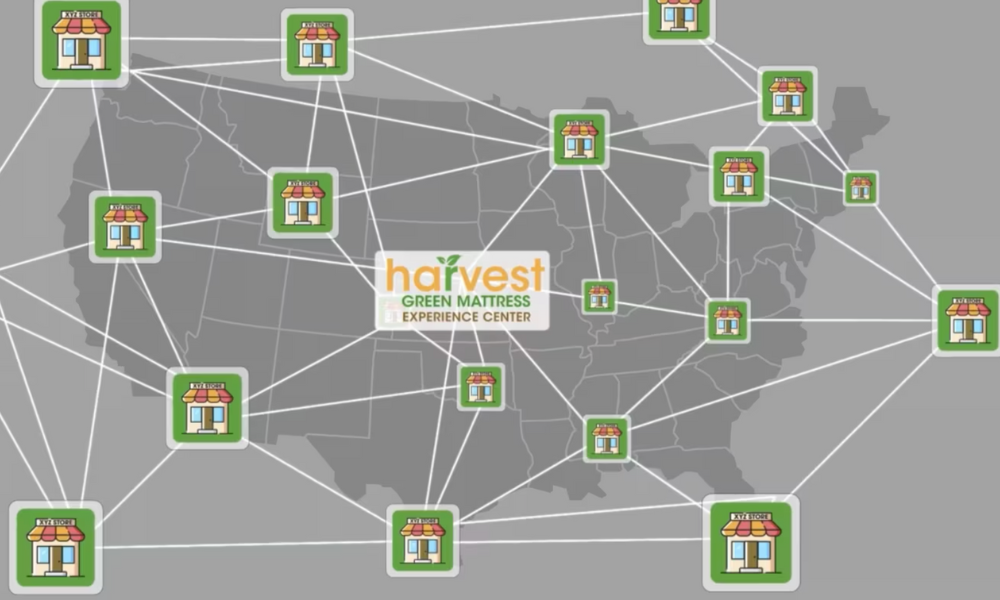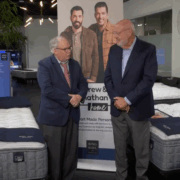Online profit-sharing models in the mattress industry are few and far between. At least that’s what I’ve found in my research around the subject.
Checking on brands like 3Z, Resident and Purple, none of these online brands offer a profit-sharing system that gives money back to retailers when mattresses are bought online in their dealers’ areas. Or at least none of them are publicizing it.
Mike Magnuson, founder and CEO of GoodBed and an online bedding guru, said if a manufacturer was doing this, he’d expect them to make it known, but he hasn’t heard of any manufacturers that do this. Except one.
Bedding Industries of America’s Harvest program was built on a profit-sharing model that gives retailers a share of the profit from Harvest mattresses purchased at marketplace retailers, like Walmart or Amazon.
So if a consumer goes into a local mattress retailer’s store, looks at a Harvest bed and then leaves to go buy it online, the retailer will get a percentage of that online sale.
James Short, who came up with the Harvest brand, says he also doesn’t know of any other mattress manufacturers that use this business model.
“A couple of companies may have tried it a few years back, but Harvest is the only one I know of that’s still doing it,” he says. “And it’s really taken off in recent years.”
Short explains that before he joined BIA in 2020, he was with Illinois Sleep, and this is where he developed the initial idea for Harvest. (BIA later acquired Illinois Sleep.)
“We saw all of these digital players coming to life and sprouting up, but we also began to notice that our core customers were going away,” Short explains. “We felt that e-commerce was having somewhat of an immediate impact.”
Fast forward a few years and online brands like Resident started selling through brick-and-mortar stores and used their immense online presence to drive traffic into these stores. For retailers, that was great. Unless the customer left the store to go buy the product online.
“I wanted to set up a model that rewinds the relationship between the manufacturer and retailer relationship back to the way it was 30 years ago,” Short says. “The retailer would advertise the brand and focus on servicing the consumer locally, and the manufacturer would focus on building beds. We have made it work, and I think that with many companies going vertical, it could be even more popular in the future.”
Three different entities work together to support the Harvest brand. BIA is the manufacturer that makes and roll-packs the beds. The second is the retailer who advertises locally to their audience to drive traffic and sell beds. The third is Contour, which owns the Harvest marketplace, controls the website and focuses on building and sharing content.
“Harvest is no different than any other traditional relationship,” Short explains. “The only difference is that when we set up a Harvest dealer we provide them with a list of zip codes, and it’s with these zip codes that they’ll get exclusivity for the product. So we won’t have another competitor within that range. The transaction can happen almost anywhere, from Facebook to Walmart.”
There is also a health aspect to Harvest that addresses harmful off-gassing from boxed beds. Short says Harvest is all about cleaner and healthier air quality and that one of the biggest complaints for mattresses bought online is the smell.
“They also let off volatile organic compounds which in the short term won’t harm you, but continued exposure to it can be harmful,” Short says. “If you eat potato chips every once in a while it’s not bad, but if you eat a bag every day there can be long-term implications.”
While Short says the program can be hard for some to immediately understand, he explains that the simplest way to explain it is that Harvest is building a brand within a modern environment through partnerships.
At the January Las Vegas Market, the company debuted its latest updates to the line to include a product mix that “rolls back to a true e-commerce presentation,” Short says. “Everything is 150 pounds or below, so it’s UPS-friendly and very efficient.”
He also says that in the future the brand may look to partner with other third-party vendors to provide sheets, pillows and other top-of-bed products through the Harvest marketplace.
In our industry, we’re witnessing consolidation, vertical integration and significant impacts from digital brands,” Short says. “The question is: Where does our industry stand in this process? Are we at the beginning, middle or nearing the final stage? One thing is clear — our industry is not immune to these shifts and both suppliers and retailers must evolve to remain relevant.




